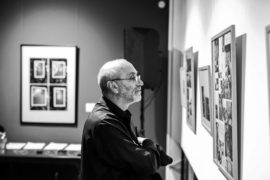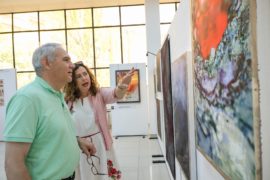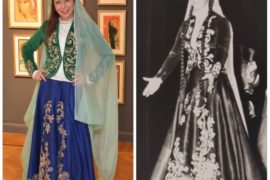A piece by Paul Guiragossian that was exhibited during Beirut Art Fair 2017
Lebanon has a large Armenian community. From restaurants to music, and even graffiti, signs of Armenian life are everywhere. Not only has Armenian migration had an influence on language and cuisine however, but also on its art. One of Lebanon’s most beloved modern artist’s, Paul Guiragossian (1926-1993), was in fact Armenian, with many of Lebanon’s most prominent collectors today also being of Armenian descent.
Born in Jerusalem to survivors of the Armenian Genocide, Guiragossian’s family moved to Lebanon, the place that the painter would call home for most of his life, when the artist was 20 years old. The artist’s paintings have a distinctive style that make his trademark long, elongated figures, that cling together in every colour of the rainbow unmissable in galleries and museums worldwide. Guiragossian’s work can be found in institutions and collections throughout the Middle East and his canvases are increasingly being featured in exhibitions and at auctions of modern and contemporary art outside of the region too in such places as Sotheby’s and Christies. His paintings are colourful and geometric, being both abstract and figurative at the same time and, while he often depicted Lebanese landscapes and themes, some of his most notable paintings are reflections on the consequences and circumstances of the Armenians of his generation, many of whom were subjected to migration. Three of his six children are also painters who inherited their father’s flair for the creative arts, and they have recently founded the Paul Guiragossian Foundation to preserve and promote his work.
Besides Guiragossian, Armenian artists are present across the Lebanese art scene. And, it is not just Armenian artists who contribute to this rich environment, but also collectors of Armenian descent. At the 2017 Beirut Art Fair the focal exhibition (curated by Lebanese-Iranian Rose Issa) drew its display from the collections of Beirut’s foremost art collectors. Among these connoisseurs of local Lebanese art were a number of Armenian names including Abraham Karabajakian, one of the best-known collectors situated in Beirut. Karabajakian is a champion of modern and contemporary artists from the region and, together with Bucharest-based collector Roger Akoury, they put their collections together in 2011, opening it up to the public. In 2011 the KA Collection was founded as one of the important centers of modern and contemporary art from the region. At the moment the collection is housed in a private location, viewable by appointment only, though the aim is to open up a space that is accessible to everyone in the centre of Beirut.
In addition to the contribution of Armenian collectors at Beirut Art Fair, Rose Issa’s exhibition, titled Ourouba: The Eye of Lebanon, also contained work produced by Armenian artists. This is significant, as the inclusion of this artwork under an exhibition with a distinctly Lebanese title affirms the importance of Armenian participation within the Lebanese cultural sphere. Paul Guiragossian appeared a number of times within the display, along with the sculptural work of Jean Boghossian. Besides Ourouba, Armenian art was also presented through the participation of Yerevan-based Aramé Gallery, which exhibited the work of Armen Gevorgian, Ruben Grigorian, Aram Hakobian, Gabriel Manoukian and Daron Mouradian, with Lebanon-based galleries Artlab, Emmagoss, Mark Hachem and 392remil393 all showcasing Armenian artists.
It appears that Armenia’s artistic presence in Lebanon is only set to rise. As recently as January of this year, Aramé Art Gallery hosted an exhibition in the trendy Beirut Souks area of downtown Beirut. The show, which was titled Celebration of Dreams, mixed realist and abstract paintings through which the participating Armenian artists created a window where the viewer could look into the artists dreams. Looking forward, the 2018 edition of Beirut Art Fair will pay tribute to Paul Guiragossian. The Lebanese-Armenian artistic alliance is one that has been long and prosperous, and it only looks set to grow.



